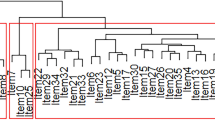Abstract
This paper reports the use of several quantitative analytic methods, including Rasch analysis, to re-examine teacher responses to questionnaire items probing opinions related to the compulsory numeracy tests conducted in Years 3, 5, and 7 in Queensland, Australia. Nisbet and Grimbeek (2004) previously reported an interpretable and statistically acceptable 6-factor exploratory factor solution. The present paper improved on this outcome by utilising Rasch analysis to identify items with orderly sequences of scores across response categories, and to subject these to fresh exploratory and confirmatory factor analysis. The resulting 3-factor scale proved acceptable in terms of exploratory and confirmatory factor analysis as well as in terms of Rasch item analysis. The paper briefly discusses the implications of these outcomes in relation to the refined instrument’s capacity to gather information about how teachers view the Queensland numeracy reporting system.
Similar content being viewed by others
References
Arbuckle, J.L. (1999). Amos (Version 4.01) [Computer Software]. Chicago: Smallwaters.
Australian Education Council. (1994a).Mathematics work samples. Melbourne: Curriculum Corporation.
Australian Education Council. (1994b).Student performance standards in mathematics for Queensland schools. Melbourne: Curriculum Corporation.
Bond, T. G., & Fox, C. M. (2001).Applying the Rasch model: Fundamental measurement in the human sciences. Mahwah, NJ: Lawrence Erlbaum.
Byrne, B. M. (2001).Structural equation modeling with AMOS. London: Lawrence Erlbaum.
Clarke, D. J. (1988). Realistic assessment. In D. Firth (Ed.),Maths counts — who cares? (pp. 187–192). Melbourne: Mathematical Association of Victoria.
Clarke, D. J., & Peter, A. (1993). Modelling teacher change. In B. Atweh, C. Kanes, M. Carss, & G. Booker (Eds.),Contexts in Mathematics Education. (Proceedings of the Sixteenth Annual Conference of the Mathematics Education Research Group of Australasia, pp. 167–175.). Brisbane: MERGA.
Department of Education, Training and Youth Affairs. (2000).Numeracy, a priority for all. Canberra: Commonwealth of Australia.
Fullan, M. (1982).The meaning of educational change. New York: Teachers College Press.
Grimbeek, P., Bryer, F., Beamish, W., & D’Netto, M. (2005). Use of data collapsing strategies to identify latent variables in questionnaire data: Strategic management of junior and middle school data on the CHP questionnaire.Proceedings of the 3rd. Annual International Conference on Cognition, Language and Special Education, Gold Coast, QLD.: Griffith University.
Guskey, T. (1985). Staff development and teacher change.Educational Leadership, 42, 57–60.
Linacre, J.M. (2004). WINSTEPS Rasch measurement computer program (Version 3.53) [Computer software]. Chicago: Winsteps.com.
Michell, J. (1999).Measurement in Psychology: A critical history of a methodological concept. United Kingdom: Cambridge University Press.
Nisbet, S., & Grimbeek, P. (2004). Primary teachers’ beliefs and practices with respect to compulsory numeracy testing. In I. Putt, R. Faragher, & M. McLean (Eds.),Mathematics education for the third millennium: Towards 2010. (Proceedings of the 27th Annual Conference of the Mathematics Education Research Group of Australasia, Townsville, Vol. 2, pp. 406–413). Sydney: MERGA.
Nisbet, S., & Warren, E. (1999). The effects of a diagnostic assessment system on the teaching of mathematics in the primary school. In O. Zaslavsky (Ed.),Proceedings of the 23rd Annual Conference of the International Group for the Psychology of Mathematics Education (Vol. 3, pp. 337–344). Haifa, Israel: PME.
Nisbet, S., Dole, S. & Warren, E. (1997). Cooperative professional development for mathematics teachers: A case study. In F. Biddulph & K. Carr (Eds.),People in mathematics education. (Proceedings of the 20th Annual Conference of Mathematics Education Research Group of Australasia, Vol. 2, pp. 369–375). Rotorua: MERGA.
Queensland School Curriculum Council. (1999).Review of Queensland literacy and numeracy testing programs, 1995–1999: Issues paper. Brisbane: Queensland School Curriculum Council.
Queensland Schools Curriculum Council. (1996).The Year 2 Diagnostic Net handbook for schools — Shaping the future. Brisbane: The Queensland Government Press.
Smith, R.M., Schumacker, R.E., & Bush, M. (1998). Using item mean squares to evaluate fit to the Rasch model.Journal of Outcome Measurement, 2, 66–78.
SPSS (2004). SPSS for Windows [Computer Software]. Chicago IL: SPSS.
Willis, S. (1998). Which numeracy?Unicorn, 24, 32–42.
Wiltshire, K., McMeniman, M., & Tolhurst, T. (1994).Shaping the future: Review of the Queensland School Curriculum. Brisbane: Queensland Legislative Assembly.
Wright, B. D., & Linacre, J. M. (1994). Reasonable mean-square fit values.Rasch Measurement Transactions, 6, 205.
Author information
Authors and Affiliations
Rights and permissions
About this article
Cite this article
Grimbeek, P., Nisbet, S. Surveying primary teachers about compulsory numeracy testing: Combining factor analysis with rasch analysis. Math Ed Res J 18, 27–39 (2006). https://doi.org/10.1007/BF03217434
Issue Date:
DOI: https://doi.org/10.1007/BF03217434




